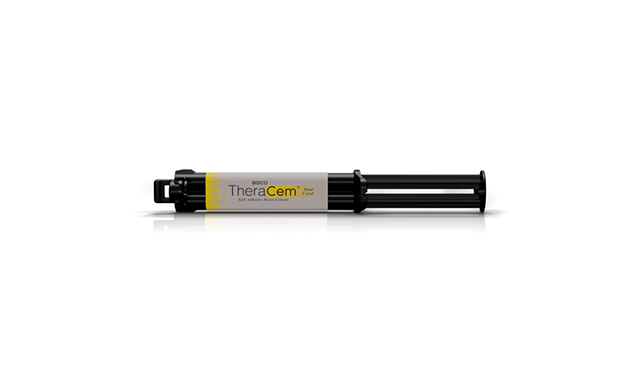Glass Ionomers or Resin Cements: The pros and cons of cements
We compare the differences between these two materials and which ones work best for specific applications

There are many options for luting indirect restorations, two of which are used by many dentists-glass ionomers and resin cement.
Let’s review the differences between the two materials.
- Glass Ionomer Cement: Glass ionomers are a mixture of glass and natural acid, usually fluoroaluminosilicate glass and polyacrylic acid. The material sets as part of an acid-base reaction that occurs when you mix the powder and liquid.[i] They are known for their ability to bond to the hard tissue of the teeth and the fluoride they release for a long time after placement.[ii]
Per the Journal of Functional Biomaterials, clinical applications are varied for these materials. They can be a liner or base for a direct restoration or even as a full restoration for primary dentition. They can also be used as a fissure sealant. For luting and bonding, glass ionomer cement uses include cementation of bridges, crowns, bridges, inlays, onlays, and orthodontic brackets.[iii]
- Resin Cement: Resin cement is a mixture of glass and polymer resin material. The materials are usually self or dual-cured resins after phosphoric acid etch and rinse step. However, there are also self-adhesive versions that eliminate etching by adding phosphoric acid into the material. They are known for their excellent bond strength and durability. Some resin cements release fluoride, but not as much as glass ionomers.[iv]
Per the Journal of the Canadian Dental Association, resin cement in indirect restorations are the best for non-metallic restoratives, like ceramic and resin composite materials. They are also used for cementing resin-bonded fixed partial dentures and can also save dislodged crowns when necessary. [v]
Each of these materials have advantages and disadvantages in specific situations. Two general dentists explain the pros and cons of each material and the cases where each performs well.
Glass Ionomers
Glass ionomers have a proven track record over a long time, says Jeff Lineberry, DDS, FAGD, is a general and cosmetic dentist who practices in Mooresville, NC. He also likes how they release fluoride.
Ketac Cem from 3M ESPE

Fluoride release is one of the more beneficial features of glass ionomers, agrees Alex Kalmanovich, DDS, a private practice dentist in Laguna Beach, Calif.
Another significant advantage of glass ionomers is that they are much more moisture tolerant than resin cement, Dr. Lineberry adds.
“Typically, resin cement is a lot less moisture tolerant,” Dr. Lineberry says.
Additionally, cleanup is easy, and it doesn't require many steps to cement the crown, Dr. Kalmanovich says.
However, its dependence on mechanical retention rather than chemically bonded adhesive cement could be a pro or a con, he says.
“It's a con because it's not universally used for every preparation. If you have a very short or tapered preparation, it probably won't be a great cement for that restoration,” Dr. Kalmanovich explains.
Some glass ionomers are soluble in water, especially during the initial setting of the matieral, which is another downside, says Dr. Lineberry. He also pointed out that it’s a weaker cement than its resin counterpart.
“Another disadvantage is that some of them are acid-base reactions, and sometimes they have a lower PH when they are setting,” Dr. Lineberry says. “Some people have post-operative sensitivity, at least initially.”
Resin Cement
One of the biggest advantages of using resin cement is the way it interacts with the tooth thanks to its improved bond strength, Dr. Lineberry says. This characteristic of resin cement is particularly helpful when you are cementing a crown that does not have as much retention form.
“If there is not as much tooth there to hold on to, we can use resin cement to help the restoration hold onto the tooth,” Dr. Lineberry says. “In other words, resin cement provides a better bond between the restoration and the tooth.”
TheraCem from BISCO

However, resin cement is also less moisture tolerant than glass ionomer cement. When using resin cement, the procedure is much more technique sensitive because the area needs to be kept dry, Dr. Lineberry advises.
Which material do the experts prefer?
CEREC® is Dr. Dr. Kalmanovich’s material of choice, and most of the restorations he places are lithium disilicate, which means he usually goes with resin cement. However, he believes there is a place in his practice for glass ionomers as well.
“Glass ionomer is a great cement. It's very easy to use, and it's moisture tolerant,” Dr. Kalmanovich says. “So, in areas where I can't isolate the tooth as well, or it's subgingival, and then there is a moisture control issue, glass ionomer would be a great cement to use. It's a lot more successful than adhesive cement in those situations.”
When deciding what cement to use, Dr. Kalmanovich uses three key considerations:
- What material is being cemented? What’s used for the restoration dictates which adhesive should be used.
- What type of indirect restoration is being placed? For example, veneers have different needs than a crown.
- What preparation being placed? If the preparation is short or below the gum line, where bleeding is hard to control, one cement should be chosen over another.
The material used depends on the type of restoration, Dr. Lineberry agrees. Each material has its advantages and disadvantages and the best situations for optimal performance. However, he describes resin-modified glass ionomers as a “happy medium.”
“Using resin-modified glass ionomers is a way to get the best of both worlds. You get something that has bond strength and durability, as well as less solubility in moisture, while at the same time moisture tolerant,” Dr. Lineberry says.
Resin-modified glass ionomers have been around since the 1980s and were originally intended to be used lining a cement, but proved to be useful in other ways, including Class II Restorations.[vi] Dr. Lineberry likes that they have a proven track record of lower sensitivity and uses them for his zirconia restorations. For e.max®, lithium disilicate, and porcelain crowns, as well as inlays and onlays, he uses resin cement.
If moisture is an issue when using a glass ionomer cement, Dr. Kalmanovich stresses the importance of ensuring there is a well-designed prep. It must have the proper retention on that tooth.
“You have to make sure that you have at least four millimeters height in the wall of the preparation, and that taper is no fewer than eight degrees,” he says. “That will allow the restoration to last a long time and be retentive.”
Adhesive cement requires multiple steps per according to the manufacturer, and clinicians must be meticulous about these steps. This can be time-consuming and tedious, Dr. Kalmanovich explains. However, the advantage of doing all those steps is enhanced strength, he adds. The improved strength is why he chooses resins most of the time, unless he can’t isolate the area as well as he would like. Furthermore, the enhanced strength is useful when the preparation has retention issues.
“If you don’t have the taper and the height of the tooth in the preparation, then adhesive cement is the one you want to choose. The increased bond strength allows that to be more retentive,” Dr. Kalmanovich.
There are so many cement choices and different systems, making a decision can be overwhelming, Dr. Kalmanovich says. He recommends picking one for each type of situation and sticking to it. For example, he suggests one resin cement, one glass ionomer, and one veneer cement.
“Don't open your refrigerator in your dental office and have 15 different kinds of cement. You're going to go crazy,” Dr. Kalmanovich says.
Whichever material is used-glass ionomers, resin cement, or resin-modified glass ionomers-dentists should choose one with a solid track record with sound research and data behind it, Dr. Lineberry suggests.
“I would have at least one of each in my armamentarium, because realistically speaking, there’s no such thing as a one-all, be-all material,” Dr. Lineberry says. “There are going to be times when a glass ionomer or a resin-modified glass ionomer is going to serve the patient much better in the clinical situation than a resin cement, and vice versa.”
References:
[i] Cho, Shiu-yin, and Ansgar C. Cheng. "A Review Of Glass Ionomer Restorations In The Primary Dentition". Cda-Adc.Ca, 2020, https://www.cda-adc.ca/jcda/vol-65/issue-9/491.html. Accessed 5 Jan 2020.
[ii] Ibid.
[iii] Sidhu, Sharanbir, and John W. Nicholson. "A Review Of Glass-Ionomer Cements For Clinical Dentistry". Ncbi.Nlm.Nih.Gov, 2020, https://www.ncbi.nlm.nih.gov/pmc/articles/PMC5040989/pdf/jfb-07-00016.pdf. Accessed 5 Jan 2020.
[iv] Segarra, Armin. "Classification Of Resin Cements". Pocket Dentistry, 2020, https://pocketdentistry.com/classification-of-resin-cements/. Accessed 5 Jan 2020
[v] Ibid.
[vi] Sidhu, S. (2011), Glass-ionomer cement restorative materials: a sticky subject?. Australian Dental Journal, 56: 23-30. doi:10.1111/j.1834-7819.2010.01293.x